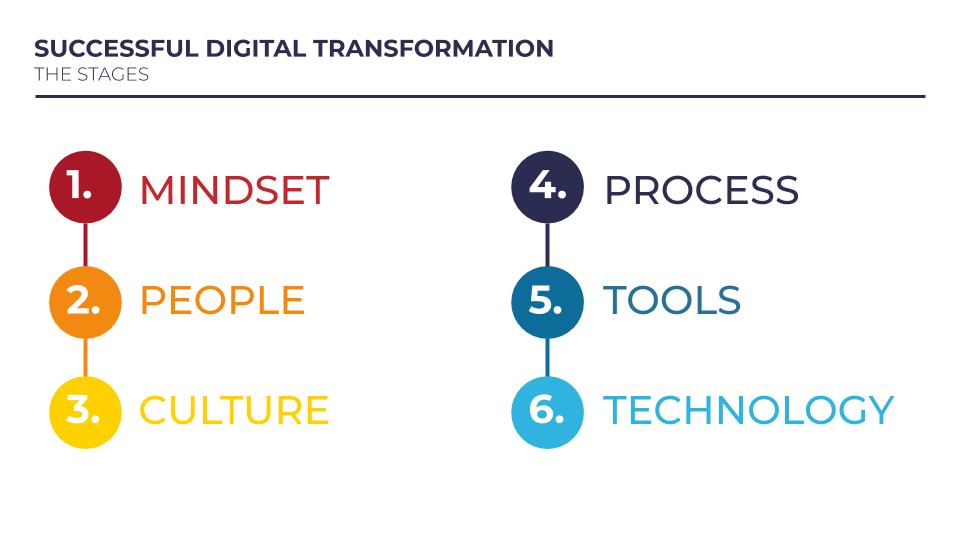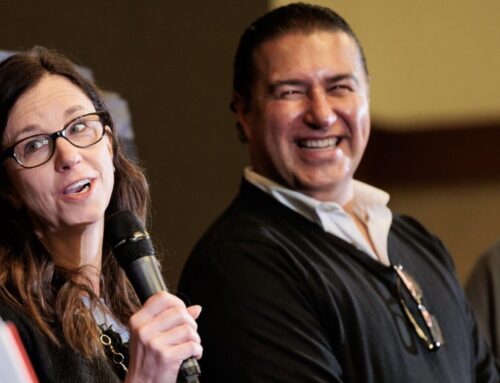Consultants over-complicate Digital and the Digital Mindset to try to trick corporates into spending millions. In this article Breakthrough’s Director of Digital Transformation de-bunks the complexity and explains why Digital Transformation is about putting your people first.
What do we mean by Digital?
We work with global clients and what we’ve found is that when I talk about ‘Digital Disruption’ or ‘Digital Transformation’ it can mean different things for different people.
When Breakthrough talk about Digital, we are talking about the Mindset needed to use technology, not the technology itself.
For us, Digital is not the same as technology.
Our distinction is that technology is the infrastructure, the software and systems – it’s the “engine”.
Digital is what drives the engine. It’s the Mindset you have towards technology. It’s what you do with the technology itself.
Digital Transformation is not all about the technology, it’s about changing the way you work.
Our simple distinction is that:
DIGITAL = TECHNOLOGY + PEOPLE
Breakthrough are experts in People.
For Breakthrough, Digital is about:
- Putting people at the centre of everything you do
- Empowering individuals to take risks and innovate
- Views challenges and failures as an opportunity for learning
In this sense, a Digital Mindset is a Growth Mindset.
A Digital Culture is a High-Performance Culture, capable of a successful Digital Transformation.
Successful Digital Transformation
A successful Digital Transformation has 6 stages.
The first stage is to create the right Mindset. The very last, is TECHNOLOGY
1 Mindset :
Start with the Outcome, before you do anything to do with technology, think about what you want to achieve and how technology might help you solve key challenges.
2. People :
Get the right people onboard.
3. Culture :
Build a culture that puts people first, is collaborative, adaptable to change and able and willing to view challenges and failures as opportunities to grow and learn.
4. Process :
Develop the processes needed to support your new ways of working.
5. Tools :
Get the tools and training in place to support and maintain the technology you use.
6. Technology :
Invest in the right technology for your Outcomes as a business.

If you start with the technology, you take the latest new shiny thing, like AI or Machine Learning and apply it to your market. It might be desirable but there’s no way of ensuring it is viable or feasible without the tools, process, culture, people and mindset in place first.
Anyone can come up with a new idea, but you need everything else to validate it and make it happen.
Digital isn’t a silver bullet, it takes a huge amount of continuous effort to make it successful.
In this short webinar I will be talking about the Mindset and the Culture needed to ensure a successful Digital Transformation.
So, first The Mindset.
Creating a Breakthrough Mindset – a Digital Mindset
For Breakthrough, a Digital Mindset is a Growth Mindset.
In the growth mindset, failure can be a painful experience. But it doesn’t define you. It’s a problem to be faced, dealt with, and learned from.
In a fixed mindset our talent and abilities are fixed. People are unwilling to trial new ideas and unwilling to fail.
There are 1000’s of Mindsets. However, in every society and every culture we’ve worked with we’ve found that there are common Mindsets and we’ve categorised them in to 4.
To find out more about the 4 mindsets we’ve identified, contact us
All of these mindsets exist in each of us. We each have inside of us the mindset to generate possibilities; we have an action-taking player; we can get stuck; and we can feel so threatened that we intervene to stop others from taking action. All of this is often unconscious.
The Breakthrough Mindset it a Growth Mindset. And a Growth Mindset is a Digital Mindset.
See Opportunity in Challenge & Failure as Feedback
This is a hugely empowering belief if you take it to heart.
Because you will Fail. It’s not a possibility it is an absolute certainty. If you’re not failing, you’re not doing what it takes to innovate.
To be able to work in this uncertainty and to risk failure and get back up again and see the learning opportunity in the fall is incredibly hard to do if you don’t have a culture to support that.
In this sense a Digital Culture is a High-Performance Culture
In a recent survey of companies going through digital transformation 63% said Culture was the biggest challenge and one that can be a great opportunity.
To have an innovative Culture, requires you to live in a place beyond your comfort zone, not one that Overloads you with it’s demands. We call this the Stretch Zone. Where you are challenged, not threatened.
At Breakthrough we call these your Performance Zones : Comfort Zone – Stretch Zone – Overload Zone
This is useful to understand as the process of innovation is similar to asking people to walk on a tightrope.
If you put the rope an inch from the ground, people will be willing to give it a go.
They’ll walk along it, they’ll probably fail the first time or a fair few times, but they’ll try and get better.
If you put that same rope 10 feet from the ground and ask people to do the same, there’s probably no way that they’ll even take one step. The risk is too great.
If you’re asking people to step out in the unknown, to risk their ideas, their pride, to be vulnerable with one another, then they have to feel safe to do so.
We call this psychological safety.
“Psychological safety is a belief that one will not be punished or humiliated for speaking up with ideas, questions, concerns, or mistakes” – Amy Edmondson
Without safety, concepts like accountability, continuous improvement, and goals are difficult to discuss. Safety unlocks the ability for the team to reflect, take on difficult challenges, and have difficult discussions.
You need psychological safety to have innovation, to do this you need to be vulnerable.
Vulnerability, Trust & Safety
People tend to think of vulnerability as touchy feely, but when I talk about it I mean it in its most courageous sense. It’s about sending a really clear signal that you have weaknesses, that you are a fallible human being and that you could use help. If that behaviour becomes a model for others, then you can set the insecurities aside and start to trust each other and help each other.
According to Daniel Coyle from the book The Culture Code, the mechanism of cooperation can be summed up as follows:
“Exchanges of vulnerability, which we naturally tend to avoid, are the pathway through which trusting cooperation is built”
If you are never vulnerable with others in your business and workplace, then people will try to cover up their weaknesses, and every little microtask becomes a place where insecurities manifest themselves.
Normally we think about trust and vulnerability the way we think about solid ground and leaping into the unknown. We need to know there is safety net to catch us if we stumble or fall from the tightrope, so first we build that trust and then we jump.
But sciences is showing that we’ve got it backwards. Vulnerability doesn’t come after trust – it precedes it. Leaping into the unknown, when done alongside others, causes the solid ground of trust to materialize beneath our feet.
When you reciprocate someone’s vulnerability it becomes a shared exchange of openness. Vulnerability is not weakness it’s strength. It is not a risk but a psychological requirement for creating trust and cooperation.
Building habits of group vulnerability is like building a muscle. It takes time, repetition, and the willingness to feel pain in order to achieve results.
Tools and Actions
So now we have 3 principles that will help you to practice vulnerability and deliver results back in the business.
The first principle is ‘Start with Yourself’
Take ownership and accountability, and role model a Breakthrough Mindset – the Digital Mindset. Be the one to start the conversation. Especially if you’re a leader. Acknowledge your own fallibility, say “I might miss something, I need to hear from you”.
You cannot change others but you can influence them. Set standards — what the team defines as acceptable behaviour and make sure you follow those standards yourself.
And ensure that everyone feels safe enough to raise concerns. Create a shared set of values and expectations about how your team works together, and ensure that you role model that behaviour.
The second principle is ‘Ask for Feedback regularly’
When there’s a failure or error, don’t blame a person, interrogate the process.
Frame the work as a learning problem not an execution problem and Ask : ‘How can we prevent that in the future, what did we learn?’
Don’t wait until something has gone wrong, do it regularly and ask others to give you feedback. Feedback is a gift. A good relationship with failure is a key component of a Digital Mindset.
We regularly do a short feedback exercise and ask everyone in the team to answer two questions, write them on a post-it and “gift” them to each other.
They are “What I appreciate about you…” “What I’d like to see more of…” The receiver takes the post-it, says thank you and that’s it. It takes 20 minutes and it’s great for boosting energy in the team and gets people used to seeking, giving and accepting feedback in the constructive way it is intended.
The third principle is Gossip Success
It has been proven that positive emotions enable and enhance cognitive processes of innovation, creativity and decision making. One Breakthrough Tool which is wonderfully simple but effective is ‘Gossip Success’
Everyone loves to Gossip, you can’t stop it. The idea of Gossiping Success is that it takes that natural human activity and transforms it into an effective tool for building energy, spirit and motivation.
Some ways that our best clients use this
- Send out a weekly email Gossip Success in the business
- Have a team meeting on Monday or Friday where you each start by Gossiping Success
- Even when doing 1-2-1 meetings start by sharing a personal success or discuss something which you have both experienced.
Instead of focusing on the negatives, focus on the positives. There are always positive dimensions to any situation or event. The challenge is to find them and broadcast them.
Gossiping Success is not about putting a positive spin on things. It is about being very honest about what has happened and recognise both the positives and the negatives. To recognise your successes you have to also know when you haven’t succeeded. Then learn from it. You can then Gossip the Success of your learning from that failure.
It can be hard and awkward to celebrate your own achievements, so start by Gossiping someone else’s achievement, it shows that you’ve seen them, you appreciate what they’re doing and it raises the energy levels and motivates both of you.
In summary
The only thing we can be sure of in the future is that change will be constant; adaptability, agility and taking ownership of how you relate to that change is the only way to ensure success in an uncertain future.
In terms of digital disruption and the digital transformation of your businesses, start with your mindset. Engage with your people, be customer centric. Develop a culture of innovation and empowerment. Create new processes to support your new ways of working. Get the right tools in place to sustain innovation. And then invest in the right technology for your Outcomes.
When working in such uncertain times, everyone needs to be able to speak authentically and honestly about the challenges and obstacles they face. People need a safe, supportive environment to work in this new way. It will take time, but with small daily shifts and the right mindset, everyone can be engaged and involved in making sure that you remain innovative in the face of disruption.
Breakthrough have been working for 30 years to lead businesses through change and accelerate their growth. We are experts in putting people at the heart of this process.
To learn about our innovative model that always delivers results, contact us.





